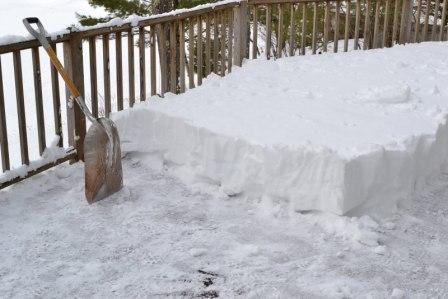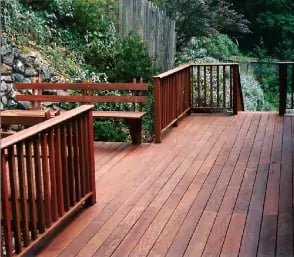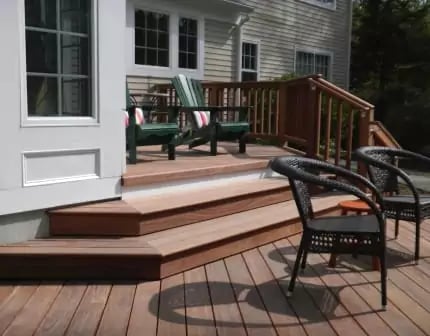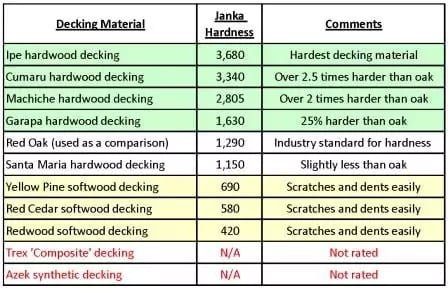
Related Posts



A client of ours recently asked if you could shovel snow off of an Ipe deck without scratching it. This great question really got me thinking about snow removal, ice removal and snow loads on decks. While the short answer to his question is yes, you can shovel snow from Ipe decking without scratching it, what if someone starts pounding away on decking boards with an ice chopper? In general, it is a very good idea to remove heavy snow from any deck surface. Some deck structures cannot handle the additional weight load. Some decking materials themselves could also be affected. Also, when the snow melts you don't want the runoff draining near (or into) your house.
A few years ago, someone I know (OK, it was my lovely and youngest daughter Emma) 'went to town' with an ice chopper on a section of cedar decking in our backyard. (She's a field hockey and lacrosse goalie, so she can be very aggressive.) She removed a lot of the ice and also gouged the soft cedar decking severely. Some of the gouges were nearly 3/16" deep. It took careful sanding to remove the gouges, yet they were so deep, you could still see the shadow of the gouge marks even after sanding them thoroughly. Softwood decking materials gouge easily.
an ice chopper on a section of cedar decking in our backyard. (She's a field hockey and lacrosse goalie, so she can be very aggressive.) She removed a lot of the ice and also gouged the soft cedar decking severely. Some of the gouges were nearly 3/16" deep. It took careful sanding to remove the gouges, yet they were so deep, you could still see the shadow of the gouge marks even after sanding them thoroughly. Softwood decking materials gouge easily.
Synthetic decking materials also gouge easily and if we had plastic decking, composite decking or plastic coated composite decking, we would not have been able to sand out or remove these gouges. However, if the decking had been a high density hardwood such as Ipe, the hardness of the Ipe wood would have eliminated or blunted any gouges to begin with and the sanding would be much easier.
 Ipe decking (and other high density hardwood decking materials) are so hard and impact resistant, it is very unlikely that shoveling snow off the surface of high density hardwood decking will leave any scratches or scratch marks. Snow plows are often used on Ipe boardwalks in places like Coney Island and Atlantic City. Obviously, this would not be the case with other decking materials like softwood decking (cedar, redwood and yellow pine) and certainly not any synthetic decking materials such as plastic decking or composite decking. These softer decking materials do not fare well with the impact of shovels. The softer the decking material, the easier the decking is to scratch. High density hardwoods like Ipe decking are the most impact resistant decking materials.
Ipe decking (and other high density hardwood decking materials) are so hard and impact resistant, it is very unlikely that shoveling snow off the surface of high density hardwood decking will leave any scratches or scratch marks. Snow plows are often used on Ipe boardwalks in places like Coney Island and Atlantic City. Obviously, this would not be the case with other decking materials like softwood decking (cedar, redwood and yellow pine) and certainly not any synthetic decking materials such as plastic decking or composite decking. These softer decking materials do not fare well with the impact of shovels. The softer the decking material, the easier the decking is to scratch. High density hardwoods like Ipe decking are the most impact resistant decking materials.

Janka Hardness testing is a commonly used rating method to measure how hard a decking or flooring material is. The Janka test is a measure of how many pounds of pressure it takes to embed a .444" inch steel ball half its depth into a piece of decking or flooring material. The higher the Janka hardness, the more difficult it is to gouge or scratch decking or flooring. Ipe decking is the hardest decking material available. Other high density hardwood decking species have very impressive measurements, too; Cumaru decking, Machiche decking and Garapa are all significantly tougher than oak.
For more information about Ipe hardwood decking and other decking material options, please follow any of the helpful links below:
Learn more about hardwood decking species
Compare decking material options
For additional information about all the commonly used decking material options, including their strengths and weaknesses, please download, "The Ultimate Guide to Selecting the Right Decking Material". Download your FREE DECKING GUIDE today by clicking the button below:


